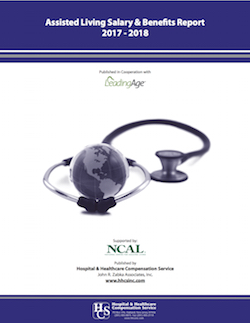
Assisted living organization CEOs, on average, saw base pay increases of 2.77% in 2017, according the 20th annual “Assisted Living Salary & Benefits Report,” just published by the Hospital & Healthcare Compensation Service. Average pay for the CEO position was $132,560.
Those national trend data reflect organizations that participated in the survey in both 2016 and 2017.
Assisted living administrators fared even better, averaging base pay bumps of 3.88%, according to the report. The increase for memory care program directors was smaller, however, at 1.71%. Average pay for the two positions was $85,627 and $62,970, respectively.
Assisted living CEOs earned less than their peers at nursing homes and continuing care retirement communities/life plan communities, where top executives averaged salaries of $110,000 and $150,000, respectively, according to all responses to the report. Assisted living administrators, however, earned more than their peers at nursing homes and CCRCs, who made $67,974 and $68,008, respectively.
Regionally, average CEO pay ranged from a low of $97,176 in Alabama/Kentucky/Mississippi/Tennessee to a high of $173,455 in Iowa/Kansas/Minnesota/Missouri/Nebraska/North Dakota/South Dakota. Assisted living administrator average pay ranged from $68,338 in Alabama/Kentucky/Mississippi/Tennessee to $113,594 in Connecticut/Maine/Massachusetts/New Hampshire/Rhode Island/Vermont. Memory care director average pay ranged from $52,222 in Iowa/Kansas/Minnesota/Missouri/Nebraska/North Dakota/South Dakota to $66,597 in Connecticut/Maine/Massachusetts/New Hampshire/Rhode Island/Vermont.
In individual states, average CEO pay ranged from $92,923 in Texas to $178,074 in Minnesota. Average assisted living administrator pay ranged from $69,381 in Florida to $128,566 in Massachusetts. Memory care director pay averaged from $49,537 in North Carolina to $65,775 in Massachusetts.
Generally speaking, CEOs, assisted living administrators and memory care directors earned more at communities that had 90 or more beds compared with those at communities of 89 or fewer beds. Average pay for all three positions was higher at not-for-profit organizations than at for-profit ones.
The report includes responses from more than 600 assisted living communities, according to Katie Smith Sloan, president and CEO of LeadingAge, which cooperated in the production of the report. The National Center for Assisted Living also supported the research, for which 79.57% of participants worked for for-profit organizations and 20.43% worked for not-for-profits. They provided compensation data related to more than 37,000 employees in 20 management and 29 nonmanagement positions nationwide. Data are reported according to for-profit and not-for-profit status, revenue size, unit size, state, county and geographic region. Also covered are 18 fringe benefits, turnover rates by department and projected salary increases for 2018. Data are effective as of October.
The report may be purchased for $350, or $275 for members of LeadingAge or NCAL.
The 2018 “Behavioral Health Salary & Benefits” study is now underway, with a deadline of March 12 and publication planned for April. Questionnaires are available online. Those with questions can contact Rosanne Zabka at [email protected] or (201) 405-0075, ext. 11.



